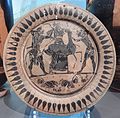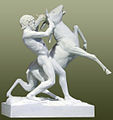 | |
| Grouping | Legendary creature |
|---|---|
| Folklore | Greek mythology |
| Other name(s) | doe with the golden horns, Golden-horned hind, Ceryneia hind, Cerynitian hind, beast with golden antlers, Parrhasian hind, nimble hind of Maenalus and beast of Maenalus. |
| Country | Greece |
| Region | Keryneia, Greece |
In Greek mythology, the Ceryneian hind (Ancient Greek: Κερυνῖτις ἔλαφος Kerynitis elaphos, Latin: Elaphus Cerynitis), was a creature that lived in Ceryneia, Greece and took the form of an enormous female deer, larger than a bull, with golden antlers like a stag, hooves of bronze or brass, and a "dappled hide", that "excelled in swiftness of foot", and snorted fire. To bring it back alive to Eurystheus in Mycenae was the third labour of Heracles.
Other names and descriptions for it were: doe with the golden horns, golden-horned hind, Ceryneia hind, Cerynitian hind, beast with golden antlers, Parrhasian hind, nimble hind of Maenalus and beast of Maenalus. Frazer says that the hind took its name from the river Cerynites, "which rises in Arcadia and flows through Achaia into the sea".
One tradition says that Artemis found a mighty herd of five Ceryneian hinds playing on the base of Parrhasian hill far away from the banks of the "black-pebbled Anaurus" where they always herded. Artemis was so impressed by the hinds that she yoked four of them to her golden chariot with golden bridles, but purposely let one escape to the Ceryneian hill to be a future labour for Heracles. Whilst in Ceryneia, the hind chased farmers from vineyards.
The Ceryneian hind was sacred to Artemis. "The hind is said to have borne the inscription 'Taygete dedicated to Artemis'." Because of its sacredness, Heracles did not want to harm the hind and so hunted it for more than a year, from Oenoe to Hyperborea, to a mountain called Artemisius, (a range which divides Argolis from the plain of Mantinea) before finally capturing the hind near the river Ladon.
Euripides says Heracles slew the hind and brought it to Artemis for propitiation. Another tradition says he captured it with nets while it was sleeping or that he ran it down, while another says he shot and maimed it with an arrow just before it crossed the river Ladon. Once Heracles captured the hind, and only after explaining to Artemis and Apollo ("who would have wrested the hind from him") that he had only hurt the sacred hind out of necessity, was he allowed to take it alive to Eurystheus in Mycenae, thus completing his third labour.

Art
-
 Athenian plate, c. 560 BC
Athenian plate, c. 560 BC
-
 Roman bronze, 1st century BC, probably a copy from Lysippus
Roman bronze, 1st century BC, probably a copy from Lysippus
-
 Roman-era bronze, 1st–2nd centuries AD
Roman-era bronze, 1st–2nd centuries AD
-
 Mosaic from Roman Spain, 3rd century AD
Mosaic from Roman Spain, 3rd century AD
-
 Statuette by J. M. Félix Magdalena (b. 1941)
Statuette by J. M. Félix Magdalena (b. 1941)
Stag or Hind or female deer
"Pindar says that in his quest of the hind with the golden horns Hercules had seen "the far-off land beyond the cold blast of Boreas. [Hyperborea]" Hence, as the reindeer is said to be the only species of deer of which the female has antlers, Sir William Ridgeway argues ingeniously that the hind with the golden horns was no other than the reindeer."
A doe bearing antlers was unknown in Greece, but the story of the hind is suggestive of reindeer, which, unlike other deer, can be harnessed and whose females bear antlers. The myth relates to the Hyperborea, which may have been the archaic origin of the myth itself, as Robert Graves thought.
Authoritative primary source translations say the creature was a:
- doe
- hind
- deer
- hart
- stag plus Pseudo-Hyginus, Fabulae 30, (trans. Grant)
- beast
Classical Literature Sources
Chronological listing of classical literature sources for the Ceryneian Hind:
- Pindar, Olympian Odes III 28 ff. (trans. Sandys) (Greek lyric poetry C5th BC)
- Euripides, The Madness of Hercules 375 ff. (trans. Way) (Greek tragedy C5th BC)
- Callimachus, Hymn 3 to Artemis 98 ff. (trans. Mair) (Greek poetry C3rd BC)
- Diodorus of Sicily, Library of History 4. 12. 13 (trans. Oldfather) (Greek history C1st BC)
- Virgil, Aeneid 6. 801 ff (trans. Dewey) (Roman epic poetry C1st BC)
- Philippus of Thessalonica, The Twelve Labors of Hercules (The Greek Classics ed. Miller Vol 3 1909 p. 397) (Greek epigrams C1st AD)
- Seneca, Hercules Furens 222 ff. (trans. Miller) (Roman tragedy C1st AD)
- Seneca, Agamemnon 833 ff (trans. Miller) (Roman tragedy C1st AD)
- Seneca, Hercules Oetaeus 1237 ff (trans. Miller) (Roman tragedy C1st AD)
- Pseudo-Apollodorus, The Library 2. 5. 3-4 (trans. Frazer) (Greek mythography C2nd AD)
- Aelian, On the Characteristics of Animals 7. 39 (trans. Scholfield) (Greek natural history C2nd AD):
- Pseudo-Hyginus, Fabulae 30 (trans. Grant) (Roman mythography C2nd AD)
- Quintus Smyrnaeus, Fall of Troy 6. 223 ff. (trans. Way) (Greek epic poetry C4th AD)
- Nonnus, Dionysiaca 25. 223 ff (trans. Rouse) (Greek epic poetry C5th AD)
- Nonnos, Dionysiaca 25. 242 ff
- Tzetzes, Chiliades or Book of Histories 2. 265 ff (trans. Untila et al.) (Greco-Byzantine history C12 AD)
- Tzetzes, Chiliades or Book of Histories 2. 495 ff
See also
References
- ^ "Hymn III (to Artemis). 98 ff.". Callimachus and Lycophron. Translated by Mair, G. R. London; New York: William Heinemann; G. R Putnam's Sons. 1921. p. 69. ark:/13960/t7qn6bw6r.
- ^ "The Library 2. 5. 3-4". Apollodorus the Library. Vol. 1. Translated by Frazer, Sir James George. New York: G. P. Putnam's Sons. 1921. pp. 191 with the Scholiast. ark:/13960/t00012x9f.
- ^ "The Fall of Troy, Book VI. 223 ff.". Quintus Smyrnaeus The Fall Of Troy. Translated by Way, A. S. London; Cambridge, Massachusetts: William Heinemann Ltd; Harvard University Press. 1984 . p. 271. ark:/13960/t2m61f62d.
- ^ Smith, W., ed. (1870). Dictionary of Greek and Roman Biography And Mythology. Boston: Little, Brown, And Company. p. 395. ark:/13960/t9f47mp93.
- ^ "Madness Of Hercules. 370 ff.". Euripides. Vol. 3. Translated by Way, Arthur S. London; New York: William Heinemann; G. P. Putnam's Sons. 1930. p. 157. ark:/13960/t6057th3x.
- ^ "Book 4. 13". Diodorus of Sicily. Vol. 2. Translated by Oldfather, C. H. London; Cambridge, Massachusetts: William Heinemann Ltd; Harvard University Press. 1967 . p. 385. ark:/13960/t7qn6bw6r.
- ^ "Olympian Odes III 28-42. 28 ff.". The Odes of Pindar. Translated by Sandys, Sir John. London; New York: William Heinemann; The Macmillan Co. 1915. pp. 37 with the Scholiast. ark:/13960/t02z1h76p.
- ^ "Hercules Oetaeus 1237 ff". Seneca's Tragedies. Vol. 2. Translated by Miller, Frank Justus. London; New York: William Heinemann; G. P. Putnam's Sons. 1929 . p. 285. ark:/13960/t7fr0065f.
- "Agamemnon 829 ff". Seneca's Tragedies. Vol. 2. Translated by Miller, Frank Justus. London; New York: William Heinemann; G. P. Putnam's Sons. 1929 . p. 69. ark:/13960/t7fr0065f.
- ^ "Hercules Furens 222 ff". Seneca's Tragedies. Vol. 1. Translated by Miller, Frank Justus. London; Cambridge, Massachusetts: William Heinemann Ltd; Harvard University Press. 1938. p. 21. ark:/13960/t71v5s15x.
- ^ "Hercules Oetaeus 17 ff". Seneca's Tragedies. Vol. 2. Translated by Miller, Frank Justus. London; New York: William Heinemann; G. P. Putnam's Sons. 1939. p. 187. ark:/13960/t7fr0065f.
- ^ "On Animals 7. 39". Aelian On the Characteristics of Animals. Vol. 2. Translated by Scholfield, A. F. Cambridge, Massachusetts: William Heinemann Ltd. 1959. p. 153. ark:/13960/t7hq6cw1k.
External links
[REDACTED] Media related to Ceryneian Hind at Wikimedia Commons
| The Twelve Labours of Heracles | |
|---|---|